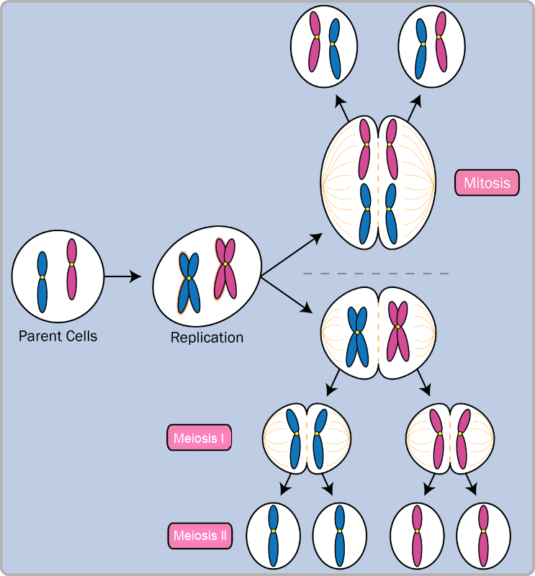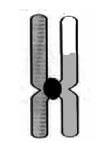MEIOSIS – LIFE SCIENCES QUESTIONS AND ANSWERS Meiosis, the process of cell division that leads to the formation of gametes, is a fundamental aspect of life sciences. Its intricate dance of chromosome segregation and genetic recombination is crucial for genetic diversity and the perpetuation of species. In this blog post, we delve into the fascinating world of meiosis, exploring common questions and providing comprehensive answers to deepen your understanding of this essential biological process.
What is Meiosis?
A simple definition of meiosis would be is this: meiosis is the process of cell division that results in the production of a haploid “daughter” cell with a haploid chromosomal number of a diploid “parent” (“original”) cell. The resulting haploid cell after meiosis would have only one part of the various homologous chromosome pairs of the parent cell.
Biology definition
Function of Meiosis
Why is meiosis important for organisms? Imagine this, if gametes (eggs and sperms) were to be produced by mitotic division only and not be meiosis, then the gametes would contain the same number of chromosomes as that of the diploid somatic cells. Consequently, when the gametes fuse during fertilization, the resulting zygote will contain four sets of the homologous chromosome and become tetraploid.
This scenario of “doubled chromosome content” will go on to the next generations and this leads to chromosomal aberrations. The chromosomal number is disrupted and unkept throughout generations. This is, in fact, a case of chromosomal abnormality. Therefore, to keep the number of chromosomes constant in each generation, gametes are produced by the process of meiosis, during the formation of gametes, meiotic cell division decreases the number of chromosomes to haploid.
So what does meiosis produce? Meiosis starts with one round of replication of chromosomal DNA, then two steps of nuclear division. As a result, four daughter nuclei (each of them is present in a new daughter cell) are produced from the meiotic division of the original cell. Each daughter cell nucleus contains only a haploid number of chromosomes. The formation of gametes haploid cells occurs in two rounds: Meiosis I and II, with DNA replication for one time only (at the S phase of interphase).
Meiosis vs. Mitosis
What is the difference between meiosis and mitosis? Meiosis and mitosis are the two main forms of cell division. The differences between them are summarized in Table 1.
| Table 1: Main differences between meiosis and mitosis | |
|---|---|
| Meiosis | Mitosis |
| Produces haploid cells (n) | Produces diploid cells (2n) |
| Includes two nuclear divisions | Includes one nuclear division |
| The product is a gamete cell | The product is a somatic cell |
| Responsible for sexual reproduction | Responsible for asexual reproduction |
| Crossing over takes place | No crossing over |
| Four cells are produced | Two cells are produced |

Phases of Meiosis
What is the process of meiosis? Meiosis is the process of four haploid cells formation from a parent diploid cell. The steps of meiosis include 2 stages: meiosis I and meiosis II. Meiosis 1 definition: the first stage in the meiotic division or the reduction division of the meiosis. This is because the number of chromosomes is reduced to half in this stage resulting in the formation of the haploid number of chromosomes.
Each pair of chromosomes come close together to exchange a part of their genetic material in a process or event called a synapse. This process occurs in the early meiosis 1 stages, particularly during prophase I.
During prophase 1 of meiosis I, the homologous pair of chromosomes come very close together and bind tightly to each other so that they almost act as one single unit. This unit is called a bivalent or a tetrad (indicating that each chromosome consists of two sister chromatids so the sum of bivalent is four chromatids). The bivalent splits into two parts after its alignment at the spindle equator so that each chromosome can move to the spindle pole at the opposite side. Consequently, each newly formed daughter nucleus after meiosis I is haploid since it has only one chromosome of the bivalent.
When do sister chromatids separate? Meiosis II which is the second stage of the meiosis cell cycle is somehow similar to mitosis where the two daughter cells are formed as a result of the separation of each two chromatids. Therefore, meiosis I is the stage at which events unique to the meiosis cycle occurs. Nevertheless, each stage of the meiotic division is subdivided in a manner that resembles the mitotic division, such as prophase, metaphase, anaphase, and telophase. However, the prophase of the first meiotic division is much more complicated and longer than the prophase of mitosis. In contrast, the prophase of the second meiotic division is simpler and shorter.
Activity 1
Question 1
Give the correct word or term for each of the statements or definitions provided below.
| 1.1 | The structure that joins the two halves of a double-stranded chromosome (1) |
| 1.2 | A pair of chromosomes, one inherited from each parent, that have the same genes at the same locus (1) |
| 1.3 | A single-stranded chromosome formed during Anaphase 2 (1) |
| 1.4 | The point of contact between two chromosomes of a homologous pair during crossing over (1) |
| 1.5 | One half of a double-stranded chromosome (1) |
| 1.6 | The phase in meiosis where crossing over occurs (1) [6] |
Answers to question 1
1.1 Centromere✔(1)
1.2 Homologous chromosomes✔ (1)
1.3 Daughter chromosome/chromatid✔ (1)
1.4 Chiasma✔/chiasmata✔ (1)
1.5 Chromatid✔ (1)
1.6 Prophase 1✔ (1) [6]
Question 2
Figure 2.12 (right) represents a process taking place during meiosis. Study the diagram and answer the questions that follow.

2.1 Provide labels for parts A, B, C and D. (4)
2.2 Name the process in meiosis that is illustrated in Figure 2.12. (1)
2.3 State ONE importance of the process you named in question 2.2. (2)
2.4 Draw a diagram of the structure labelled A to show its appearance immediately after the process you named in question 2.2. (2) [9]
Answers to question 2
2.1
A – Chromosome✔
B – Centromere✔
C – Chromatid✔
D – Chiasma✔/chiasmata (4)
2.2 Crossing over✔ (1)
2.3 It introduces genetic✔ variation✔ (2)
2.4
- A double-stranded chromosome with the strands joined by a centromere✔
- There is evidence of crossing over.✔ (2)

Question 3
Figure 2.13 (below) represents an animal cell in a phase of meiosis. Study the diagram and answer the questions that follow.

3.1 State whether the phase of meiosis shown in Figure 2.13 is meiosis I or meiosis II. (1)
3.2 Give ONE visible reason for your answer in question 3.1. (1)
3.3 Identify the parts labelled A and B. (2)
3.4 How many chromosomes:
- were present in the parent cell before meiosis began? (1)
- will be present in each cell at the end of meiosis? (1)
3.5 State ONE place in a human female where meiosis would take place. (1)
3.6 Could the cell represented in Figure 2.13 be that of a human? (1)
3.7 Explain your answer to question 3.6. (2)
3.8 Give TWO reasons why meiosis is biologically important. (2)
3.9 Give the term for the situation when some of the chromosomes do not separate correctly during the phase shown in Figure 2.13. (1) [13]
Answers to question 3
3.1 Meiosis II✔ (1)
3.2 Daughter chromosomes/chromatids are being pulled to the opposite poles✔ (1)
3.3
A – Spindle fibre✔
B – Cell membrane✔ (2)
3.4
a) 8✔
b) 4✔ (2)
3.5 Ovaries✔ (1)
3.6 No✔ (1)
3.7 There are only 4 chromosomes present3 instead of 23.✔ (2)
3.8
- It introduces genetic variation.✔
- It balances the doubling effect of fertilisation as it halves the number of chromosomes in the sex cells.✔ (2)
3.9 Non-disjunction✔ (1) [13]
Question 4
The diagram below shows the nuclei of the four cells that resulted from meiosis of chromosome pair 21 in a woman.

Figure 2.14: Diagram that shows the nuclei of four cells resulted from meiosis
4.1 Explain why nucleus N does NOT have a chromosome pair 21. (2)
4.2 Name and explain the disorder that will result if diagram M represents an egg cell that fuses with a normal sperm cell. (3) [5]
Answers to question 4
4.1 During Anaphase 1 the chromosome pair 21 does not separate✔/ non-disjunction. Gamete M will have an extra copy of chromosome number 21 and therefore gamete N does not have a copy of chromosome 21✔ (2)
4.2 Down syndrome✔/Trisomy 21 if gamete M fuses with normal sperm having 1 copy of chromosome 21 ✔ the resulting zygote will have 3 copies of chromosome 21✔ (3) [5]
